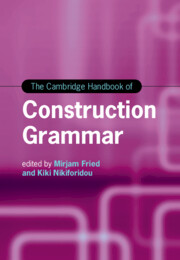Book contents
- The Cambridge Handbook of Construction Grammar
- Cambridge Handbooks in Language and Linguistics
- The Cambridge Handbook of Construction Grammar
- Copyright page
- Contents
- Figures
- Tables
- Contributors
- Acknowledgments
- Construction Grammar
- Part I The Constructional View of Language
- Part II Methodological and Empirical Foundations of Constructional Research
- Part III Case Studies in Constructional Morphosyntax
- Part IV Multimodality and Construction Grammar
- Part V Constructions in Sociocultural and Typological Variation
- 17 Constructions in Typological and Cross-Linguistic Context
- 18 Constructions and Language Contact
- 19 Constructions and Lectal Variation
- 20 Construction Discourse
- Part VI Constructional Applications
- Index of Terms
- Index of Languages
- Index of Constructions
- References
18 - Constructions and Language Contact
from Part V - Constructions in Sociocultural and Typological Variation
Published online by Cambridge University Press: 30 January 2025
- The Cambridge Handbook of Construction Grammar
- Cambridge Handbooks in Language and Linguistics
- The Cambridge Handbook of Construction Grammar
- Copyright page
- Contents
- Figures
- Tables
- Contributors
- Acknowledgments
- Construction Grammar
- Part I The Constructional View of Language
- Part II Methodological and Empirical Foundations of Constructional Research
- Part III Case Studies in Constructional Morphosyntax
- Part IV Multimodality and Construction Grammar
- Part V Constructions in Sociocultural and Typological Variation
- 17 Constructions in Typological and Cross-Linguistic Context
- 18 Constructions and Language Contact
- 19 Constructions and Lectal Variation
- 20 Construction Discourse
- Part VI Constructional Applications
- Index of Terms
- Index of Languages
- Index of Constructions
- References
Summary
After a long tradition of studying languages as isolated systems, researchers are increasingly aware of the fact that speakers of most of the world’s languages are multilingual. The coexistence of multiple languages within the brain can be a significant force shaping each. The recognition of constructions and their arrays of constructional properties provides a useful tool for understanding contact phenomena: much of what is transferred in contact situations are constructions or constructional features. Conversely, examination of what is replicated can enhance our understanding of the nature of linguistic knowledge. Here replicated constructions of varying sizes and degrees of schematicity are first described, from words through discourse structures, then the transfer of individual constructional features, including prosody, special connotations, various pragmatic effects, linguistic and extralinguistic contexts of use, and frequency are discussed, as well as the social situations under which they occur. The kinds of constructions and constructional properties replicated provide additional evidence that constructions are more than simple combinations of basic form and meaning.
- Type
- Chapter
- Information
- The Cambridge Handbook of Construction Grammar , pp. 469 - 496Publisher: Cambridge University PressPrint publication year: 2025

